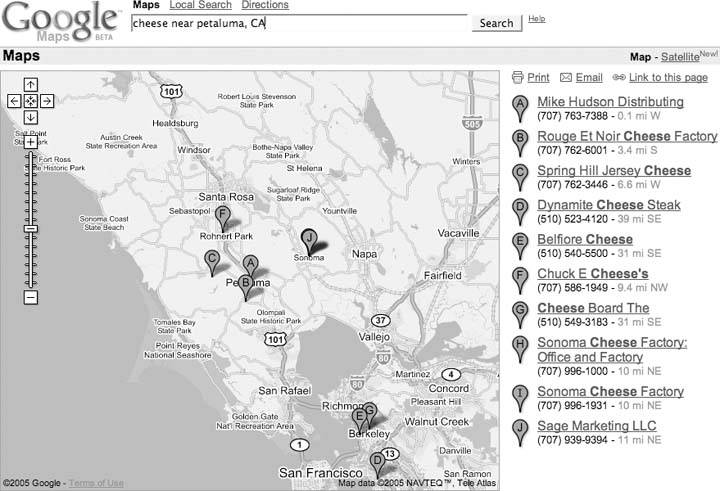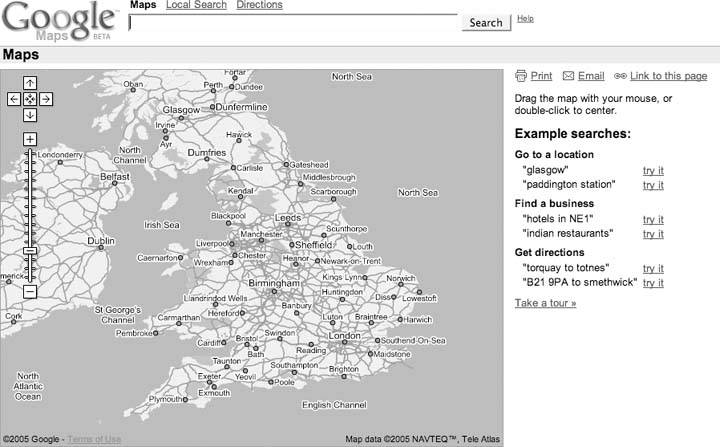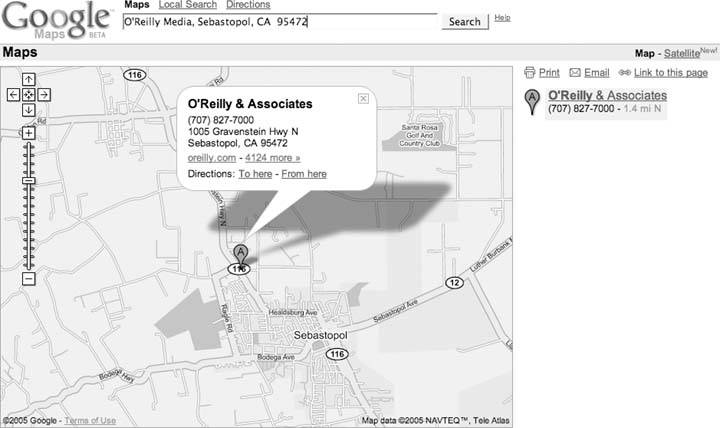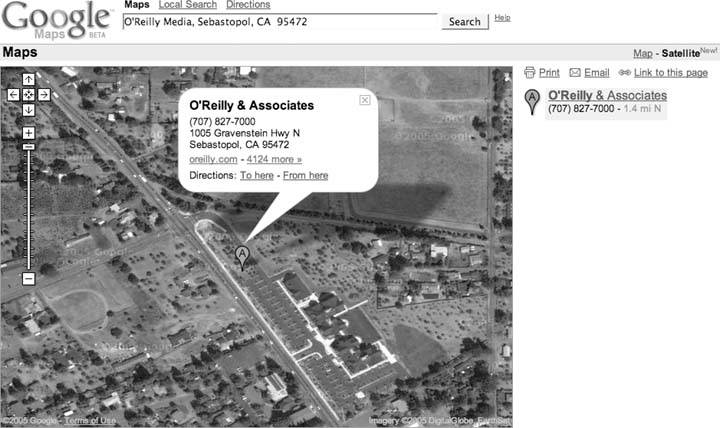Hack 1. Get Around http://maps.google.com
Hack 1 Get Around http maps google com


Sometimes you need a map to the map.
Google applied its trademark, carefully designed simplicity, to provide us with its (first) view of place. Go to http://maps.google.com/, and you'll get the view shown in Figure 1-1. If you want maps of the United Kingdom, try http://maps.google.co.uk/, and you'll get the view in Figure 1-2. A similar map exists for Japan at http://maps.google.co.jp/.
This shows us what appears as a standard Google search box (called the Location Search box), an overview or orientation map of the country in question, and a results area with instructions and sample searches.
Figure 1-1. http://maps.google.com/

Figure 1-2. http://maps.google.co.uk/

|
1.2.1. What's Different About Google Maps?
Google Maps is a web mapping service that solves the same old problem of online mapping. So why, ten years or more into the web revolution, is Google Maps such a big deal? Some of the excitement comes from the Google name and its philosophy. Google states on its corporate philosophy page at http://www.google.com/corporate/tenthings.html that "you can make money without doing evil." However, more of the interest in Google Maps may stem from other ideas stated on the philosophy pagefor example, "The interface is clear and simple" and "Pages load instantly."
Clean pages and fast performance? A commitment to avoid doing evil? Which drives traffic and mind share? Maybe at this moment on the Web you can have it all. In addition to these features, Google Maps also offers a number of innovations in web user interfaces.
Single search box
The first thing that draws attention is that Google uses a single search box for location searches. Do you want to look up an address? Just type it in the box. No more tabbing between different fields for street address, city, state, and ZIP Code! (In Internet Explorer, you can even paste multi-line addresses into this box, believe it or not.)
Draggable maps
The standard in web mapping is the usual web interface, in which you click on a button to pan the map and see more terrain. What if you wanted to just click and drag to navigate the map? Well, now you can!
Integrated local search
You can use that single search box to look for the things you want, such as "hotels near Sebastopol," or, for more choices, "hotels near SFO" (SFO is the code for San Francisco International Airport). If you just want to find all the hotels in a given area, zoom into that area, then search for "hotels," and Google Maps will constrain its search to the area shown on the map.
Satellite imagery
With a single click you can flip between viewing a map and viewing satellite or aerial photography [Hack #4]. How cool is that?
Keyboard short cuts
You don't need to click and drag your mouse, or strive to hit the little Zoom In and Zoom Out icons: you can use the arrow keys to move around in your map [Hack #3].
1.2.2. Getting Around
Google Maps starts with the overview map shown in Figure 1-1. You can move around that map by clicking and dragging your mouse on the map, by double-clicking your mouse on the map, or by using the arrow keys. Holding the mouse button down and dragging will cause the whole map to move, as if the web browser is providing a small window onto a much larger map. If you double-click on a spot, the map will smoothly pan until the point you clicked on is centered. Using the arrow keys has the same effect as clicking and dragging with the mouse. We explore the user interface in more detail in "Navigate the World in Your Web Browser" [Hack #3].
1.2.3. Entering a Location
There are many ways to enter locations [Hack #2], but let's start off easy. The conventional way of entering a location is a street address. We've come to accept address lookups in online mapping services as commonplace, but there is a great deal of behind-the-scenes work. In order to display a map of a street address, the system must first find a latitude and longitude that corresponds to this address. The process of linking something (e.g., a street address) with a latitude and longitude is called geocoding.
When you enter a query into the search box, Google takes your input and does its best to turn it into a location that can be mapped. So let's start close to home and enter the street address of O'Reilly Media headquarters into the search box:
1005 Gravenstein Highway North, Sebastopol, CA 95472
You could also enter the company name and get the same result:
O'Reilly Media, Sebastopol, CA 95472
Click Search and you'll get the map shown in Figure 1-3, which shows the address (as best as Google can determine) and hyperlinks to get directions to or from this spot.
The satellite view in Figure 1-4 (zoomed in from the area shown in Figure 1-3) clearly shows that the O'Reilly Empire is centered in a parking lot median strip….
You can also enter a street intersection; for example:
Hollywood & Vine St, Hollywood, CA 90068
The act of looking up a location has set your search area, or the extents of your search area, and you can now use the search box to get more information. For example, if you first zoom in to San Francisco, you can then search for "great sushi" and return results limited to the San Francisco area.
Figure 1-3. A Google map of O'Reilly Media's headquarters

Figure 1-4. O'Reilly Media, apparently located in a median strip of a parking lot

The Google Maps tour suggests that a search on "Great Sushi in New York" is useful. It turns out that "great sushi in San Francisco" also brings up a list of restaurants, but for some reason, "great sushi in Sebastopol" just doesn't work. To be fair, "great sushi in Sebastopol, CA" does bring up our two sushi places. But it also brings up the Larkspur Elementary School District, 37 miles from Sebastopol.
Varying the adjective usedsay from "great" to "mediocre"brings up a new grouping of restaurants. These are not the same places that show up when you do a Google search on "mediocre sushi in San Francisco," so I'm not sure what the qualifications are. "Cheap but filling sushi in San Francisco" might be a more palatable search!
Finding meaningful results for local search is still an unsolved problem. Fortunately, Google is good at searchand getting better all the time.
You Are Here: Introducing Google Maps
- Hacks 19: Introduction
- Hack 1. Get Around http://maps.google.com
- Hack 2. Find Yourself (and Others) on Google Maps
- Hack 3. Navigate the World in Your Web Browser
- Hack 4. Get the Birds-Eye View
- Hack 5. Driven to a Better User Interface
- Hack 6. Share Google Maps
- Hack 7. Inside Google Maps URLs
- Hack 8. Generate Links to Google Maps in a Spreadsheet
- Hack 9. Use del.icio.us to Keep Up with Google Maps
Introducing the Google Maps API
- Hacks 1016: Introduction
- Hack 10. Add a Google Map to Your Web Site
- Hack 11. Where Did the User Click?
- Hack 12. How Far Is That? Go Beyond Driving Directions
- Hack 13. Create a Route with a Click (or Two)
- Hack 14. Create Custom Map Markers
- Hack 15. Map a Slideshow of Your Travels
- Hack 16. How Big Is the World?
Mashing Up Google Maps
- Hacks 1728: Introduction
- Hack 17. Map the News
- Hack 18. Examine Patterns of Criminal Activity
- Hack 19. Map Local Weather Conditions
- Hack 20. Track Official Storm Reporting
- Hack 21. Track the International Space Station
- Hack 22. Witness the Effects of a Nuclear Explosion
- Hack 23. Find a Place to Live
- Hack 24. Search for Events by Location
- Hack 25. Track Your UPS Packages
- Hack 26. Follow Your Packets Across the Internet
- Hack 27. Add Google Maps to Any Web Site
- Hack 28. How Big Is That, Exactly?
On the Road with Google Maps
- Hacks 2941: Introduction
- Hack 29. Find the Best Gasoline Prices
- Hack 30. Stay Out of Traffic Jams
- Hack 31. Navigate Public Transportation
- Hack 32. Locate a Phone Number
- Hack 33. Why Your Cell Phone Doesnt Work There
- Hack 34. Publish Your Own Hiking Trail Maps
- Hack 35. Load Driving Directions into Your GPS
- Hack 36. Get Driving Directions for More Than Two Locations
- Hack 37. View Your GPS Tracklogs in Google Maps
- Hack 38. Map Your Wardriving Expeditions
- Hack 39. Track Your Every Move with Google Earth
- Hack 40. The Ghost in Google Ride Finder
- Hack 41. How Google Maps Got Me Out of a Traffic Ticket
Google Maps in Words and Pictures
- Hacks 4250: Introduction
- Hack 42. Get More out of What You Read
- Hack 43. Dont Believe Everything You Read on a Map
- Hack 44. You Got Your A9 Local in My Google Maps!
- Hack 45. Share Pictures with Your Community
- Hack 46. Browse Photography by Shooting Location
- Hack 47. Geotag Your Own Photos on Flickr
- Hack 48. Tell Your Communitys Story
- Hack 49. Generate Geocoded RSS from Any Google Map
- Hack 50. Geoblog with Google Maps in Thingster
API Tips and Tricks
- Hacks 5161: Introduction
- Hack 51. Make a Fullscreen Map the Right Way
- Hack 52. Put a Map and HTML into Your Info Windows
- Hack 53. Add Flash Applets to Your Google Maps
- Hack 54. Add a Nicer Info Window to Your Map with TLabel
- Hack 55. Put Photographs on Your Google Maps
- Hack 56. Pin Your Own Maps to Google Maps with TPhoto
- Hack 57. Do a Local Zoom with GxMagnifier
- Hack 58. Find the Right Zoom Level
- Hack 59. Show Lots of StuffQuickly
- Hack 60. Make Things Happen When the Map Moves
- Hack 61. Use the Right Developers Key Automatically
Extreme Google Maps Hacks
- Hacks 6270: Introduction
- Hack 62. Find the Latitude and Longitude of a Street Address
- Hack 63. Read and Write Markers from a MySQL Database
- Hack 64. Build Custom Icons on the Fly
- Hack 65. Add More Imagery with a WMS Interface
- Hack 66. Add Your Own Custom Map
- Hack 67. Serve Custom Map Imagery
- Hack 68. Automatically Cut and Name Custom Map Tiles
- Hack 69. Cluster Markers at High Zoom Levels
- Hack 70. Will the Kids Barf? (and Other Cool Ways to Use Google Maps)
EAN: 2147483647
Pages: 131

